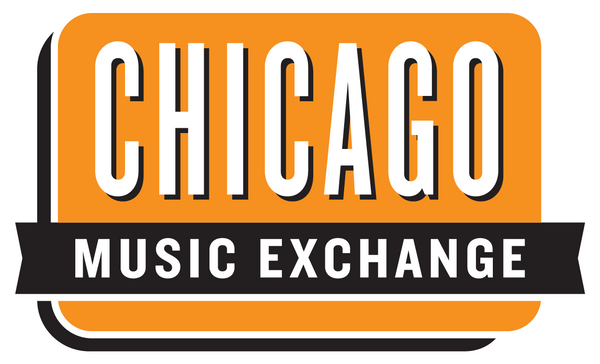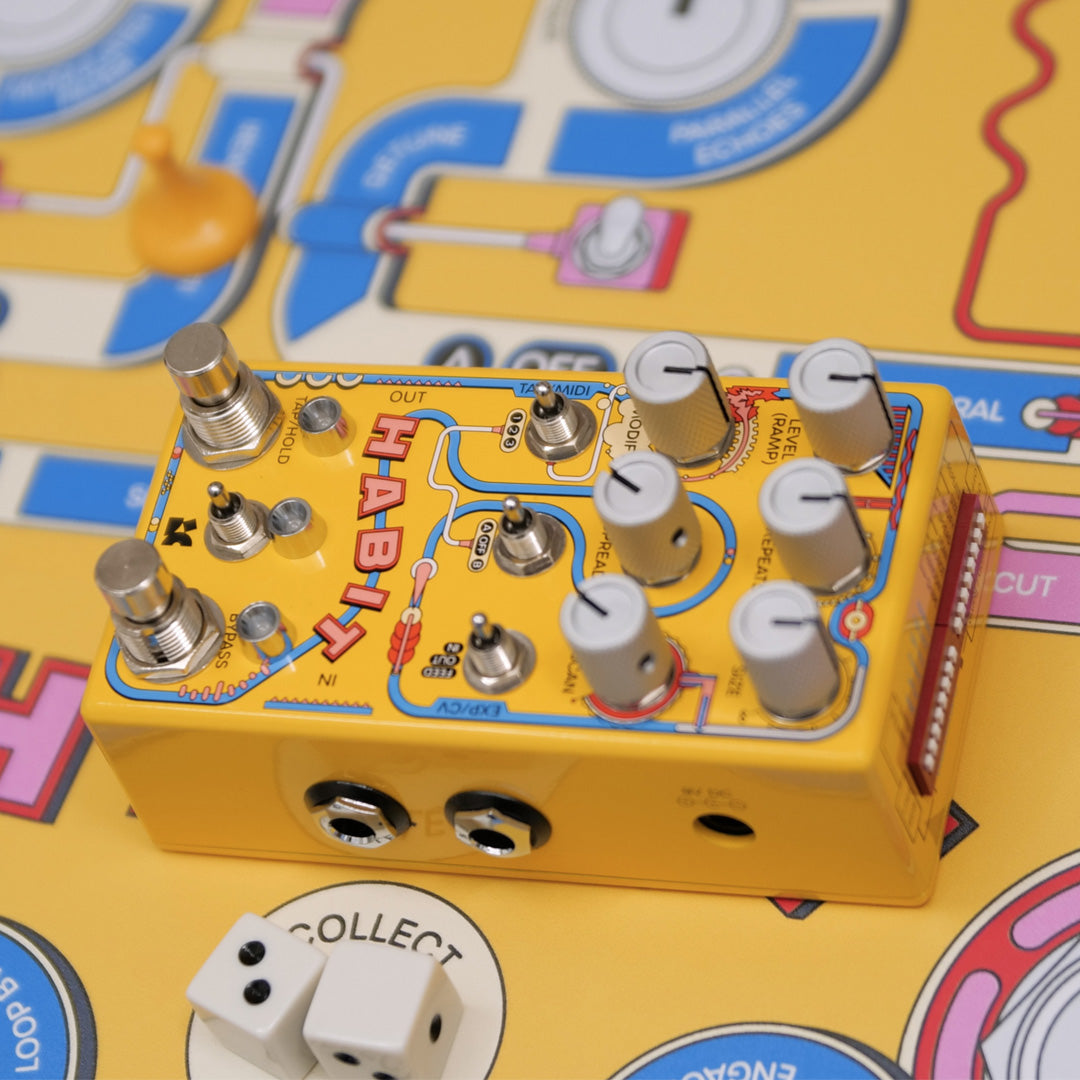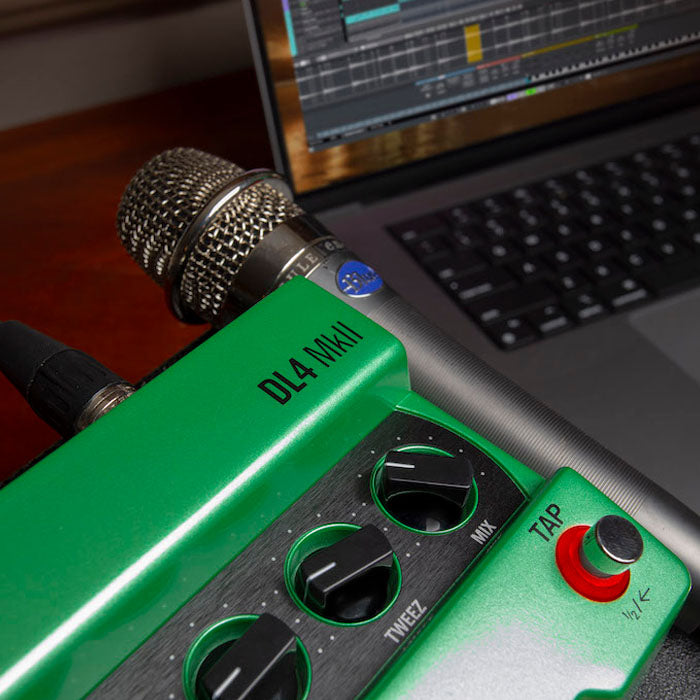The Evolution of Delay
The Evolution of a Sound Effect
In a rare moment of recurrence and recognition, the staff here at CME couldn’t help but notice the seemingly historical significance of three iconic delay pedals that debuted in March 2022: the BOSS RE-202 Space Echo, Line 6’s DL4 MKII, and Chase Bliss Audio’s Habit—all within the same month!
Looping all the way back to the origins of delay, first discovered in the 1950s by studio pioneers experimenting with reconfigurations of magnetic heads in reel-to-reel tape recording machines to create tape-based echo effects—which eventually culminated in the ‘70s with Roland’s legendary RE-201 Space Echo—a new era in the history of delay began in 1977 with the first pedal-format analog guitar effects pedals. Even despite digital delay’s promise of fewer time constraints, it took more than 20 years for a Line 6 modeling pedal to show analog delay purists the sonic potentials to be unlocked with longer sampling times, until finally arriving at the present day, in which manipulating a digital buffer with granular effects creates time-warping, mind-boggling aural odysseys. Altogether, the three digital delay pedals released in March 2022 seemed to us to mark the dawn of a whole new era in digital delay pedals—plus, a landmark moment in the history of delay!
Looping Back to the Start
Fittingly, the recent trifecta of delay pedals—all of which feature digital buffers—seemed to mark another recurrence, or return to the start of the decades-long loop when the first mass-market analog delay pedal—Electro-Harmonix’s Memory Man—was introduced in 1977. But, the first Memory Man pedal was immediately followed by its own set of delay pedal competitors, including the MXR Analog Delay, and BOSS’s DM-1 Delay Machine—each of which became widely popular in their own regard, and together helped begin to define the sonic characteristics of many classic delay pedals that we still know and love today.
Although the BOSS RE-202 is a digital delay pedal, there may be no better pedal to illustrate why analog delay pedals remained the preferred pedal preferred among guitar players and gear lovers—even following the introduction of digital delay pedals, as early as the ‘80s—until roughly the early 2000s, when the Line 6 DL4 changed the game.
Designed to authentically reproduce the warmth, saturation, and natural modulation characteristics of the original reel-to-reel tape-echo effects units—in which a mixer is used to feed the output from the magnetic “Play” head back into the “Record,” head, producing multiple, fading repeats and imparting aural effect of perceptible space and ambiance—the BOSS RE-202 pedal recreates the aural qualities and behaviors of the Roland RE-201 Space Echo studio effects unit. In addition to the satisfying roundness and coloration, the natural modulation resulting from physical quirks in the machines—and/or in the tape—caused a satisfying wow and flutter, and the Space Echo gave engineers precise control over these effects.
While analog pedals may not use magnetic tape, the bucket-brigade delay chips that made it possible to house delay in a pedal format imparted their own unique colorations, which drove audio aficionados to develop personal preferences for their taste in types of analog delay, while eschewing the digital buffer formats that modeled the original analog pedals—even despite any added of benefits of digital buffers.
Delayed Until the Digital Age
Ironically, early digital delays that often went overlooked during the era of analog devotion are now beloved for their quirks. But for digital delay pedals to really take hold, it would take the debut of Line 6 DL4 to finally illuminate the possibilities of extended loop times—and to more than just guitar players.
To do so, the DL4 had to pass muster with the analog world by paying rightful homage to the sonic characteristics of its iconic analog predecessors, encapsulating the sounds and various functions of the most prized analog delay pedals leading up to the moment when the DL4, itself, came along—all within a single pedal.
While the Line 6 Pod, released in 1996, proved how accurate and accessible digital amp models could be, the brand’s gear gurus focused their digital modeling efforts around a single, all-but-standard effect—delay—to show analog devotees what a digital buffer can really do—especially for applications, like loop sampling requiring pristine repeats—plus, more flexibility, longer sampling times, and the ability to manipulate the delay buffer with modulation effects.
A Matter of Time: Expanding Sonic Horizons
After 23 years of the DL4 being at the top of the pile in the digital delay effect pedals market—both due to its accurate modeling of classic delay characteristics, as well as the added loop sampling capabilities—Line 6 recently released the updated and expanded DL4 MKII—which, just like its predecessor, embodies a whole heritage of delays leading up to it, including the 15 delays featured on the original.
But, then, to our surprise, right after the DL4 MKII, we at CME suddenly recognized that we were witnessing a recurrence—what we here in Chicago like to call a “repeat three-peat”—when Chase Bliss Audio announced the arrival of Habit, an experimental delay pedal with a memory bank that stores up to three minutes of audio, plus seemingly endless ways to manipulate and modulate the delay, letting users create sounds no delay pedal has yet been capable of producing.
Starting off what looks to be another half-century-long loop in audio recording, loop sampling, and aural experimentation—just like when the first three analog delay pedals that dropped in 1977—the RE-202, DL4 MKII, and Habit, together, trace the lineage of popular digital delay effect being used today—and we here at CME are willing to bet they’ll continue to do so for many years to come! Come try all three at CME today!




Line 6 DL4 MKII Delay Modeler Pedal
Fans of the original DL4 delay pedal will find all of their favorite sounds exactly where they expect them to be, with the same Tweak and Tweez control parameter assignments they've become accustomed to. The 15 new MkII delays were drawn from the HX family of amp and effects processors, and include both more recent versions of classic effects and cutting-edge Line 6 originals such as the super-vibey Glitch Delay.
The DL4 MkII features a simple 1-Switch looper in addition to a classic 4-Switch looper, both of which provide up to 240 seconds of recording time. By inserting an optional microSD card into the slot on the rear of the pedal, recording time may be extended up to several hours and a loop may be stored across power cycles. The loopers operate in either mono or stereo, and may be positioned in the signal chain before or after other effects.
MICROPHONE INPUT
It's no secret that the DL4 has been used for processing and looping by lots of people besides guitarists, including vocalists and others who capture their performance with a microphone. Now, dynamic microphones can be plugged directly into the pedal's XLR Mic input, eliminating the need for converter cables, mixers, or other external devices. This feature also makes the DL4 MkII a handy tool for sound designers and other sonic adventurers.
Onboard MIDI In and Out/Thru DIN connectors enable the DL4 MkII to receive continuous controller, program change, and other MIDI messages from external sources such as MIDI controllers, thus allowing parameters to be modified dynamically and presets to be selected remotely. The DL4 MkII provides access to three presets using the A, B, and C footswitches, or six if the Tap switch is set to toggle between two banks of presets (A,B, C and D, E, F). But the DL4 MkII can store up to 128 presets, selectable via MIDI.
- Identical knob and footswitch layout as the original DL4
- 30 Delays: 15 new MkII plus 15 Legacy DL4
- 2 Looper types—mono/stereo and pre/post signal path options
- Up to 240 seconds of looping time, or several hours with optional microSD card
- XLR dynamic microphone input for vocal processing and looping
- MIDI In, Out/Thru DIN connectors—receives PC and CC messages
- 128 Presets via MIDI, with footswitch control of up to six
- Switchable true, buffered, or DSP bypass
- Input for optional expression pedal or two additional footswitches


Chase Bliss Habit Experimental Delay Pedal
It’s an effect that can become an instrument at any time, an evolving paint-splatter of everything you do. A musical sketchpad.
- 60 Seconds of Delay Time
- Modifiers
- Multi-Tap
- Looping
Record free-form songs right in the pedal, navigate through a whole performance with the turn of a knob, and yes, make echoes.
Related Posts
Mesa/Boogie | Mark IIC+ Amplifiers
A Legend Returns! Mesa/Boogie’s Mark IIC+ Amplifiers are back and better than ever. Whether you’re after the iconic Head or the portable 1x12 Combo, these amps deliver the vintage Boogie tone that shaped rock history. Shop now at Chicago Music Exchange and own a piece of guitar legend!
View DetailsDownload the CME App
Discover the ultimate shopping experience with the Chicago Music Exchange Mobile App! Explore our unparalleled collection of over 14,000 guitars, amps, synthesizers, drums, microphones, and accessories—all at your fingertips. Stay ahead of the game with tailored notifications about new arrivals, price drops, and restocks, personalized to match your browsing and purchase preferences. Enjoy exclusive access to gear and merchandise available only at CME, and don’t miss out on app-specific product giveaways. Plus, selling or trading gear has never been easier—simply use your smartphone camera to upload details directly through the CME Sell & Trade Form. Download the app today and unlock a world of music-making possibilities!
View DetailsIntroducing | Hiwatt & WEM Amplifiers
Unleash the sound of rock history with Hiwatt and WEM amplifiers at Chicago Music Exchange! From the bold clarity of Hiwatt, a cornerstone of classic British rock favored by legends like The Who and Pink Floyd, to the vintage warmth of WEM, which powered unforgettable performances of the '60s and '70s, these amps deliver iconic tones with unmatched quality. Shop Hiwatt and WEM amplifiers in-store, online, or on the CME App, and bring the golden age of rock to your sound!
View Details








